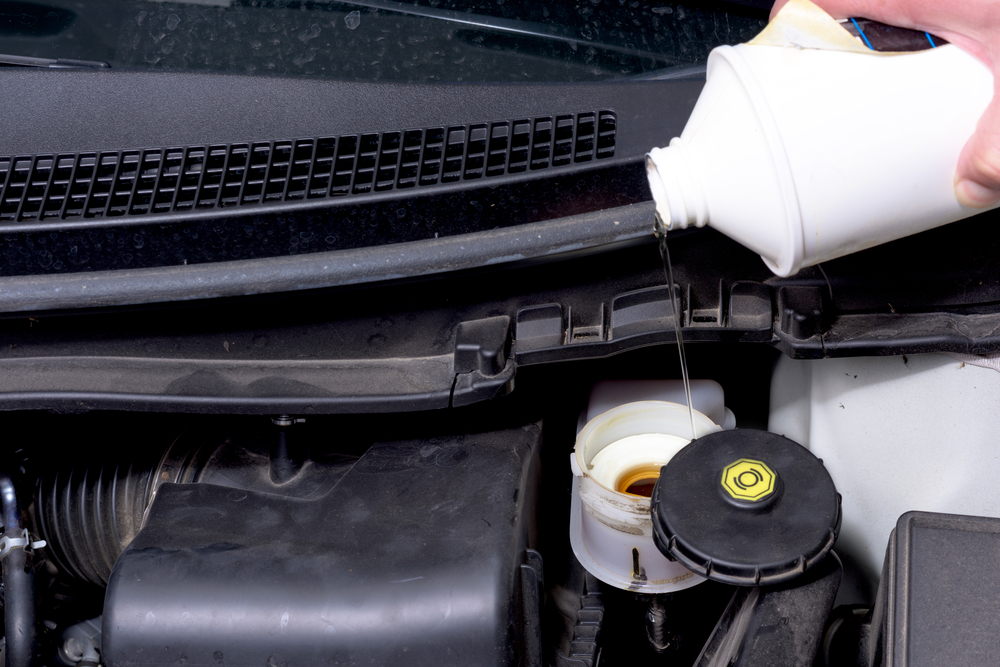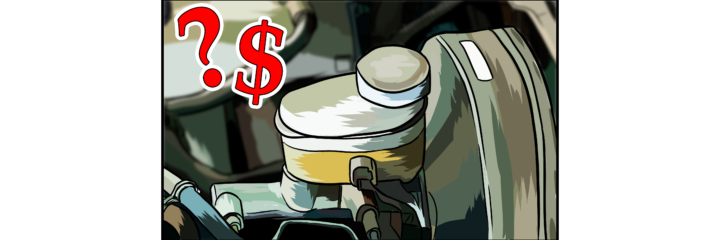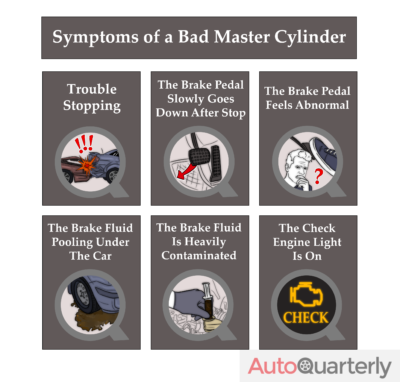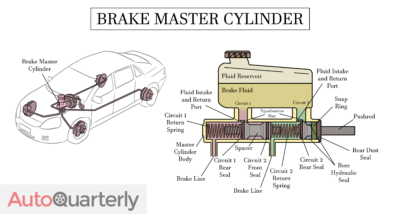Brakes are really important to the safe operation of your vehicle. If your car has trouble stopping, you are a hazard to other people and yourself. The good news is that it’s very, very rare for a brake system to fail completely. Brake systems are redundant and very simple, and when something begins to fail, you can usually tell before a catastrophe.
One of the components that can fail is the master cylinder. In this guide, we’ll explore the symptoms of a bad master cylinder, what a master cylinder is, and how to fix the problem.
Symptoms of a Bad Master Cylinder
First things first: if you have issues coming to a safe stop, don’t drive the car anymore. The line between “fading” and “complete failure” is thin when it comes to hydraulics. Even if that only means losing half your brakes, it is incredibly unsafe, and it can cause an accident.
Losing just the front brakes can mean a 75% reduction in stopping power; you will not stop before the limit line in an intersection.
Common Indicators
That being said, the following are signs that your master cylinder may be going bad. Sometimes it’s not bad enough yet that you need to stop driving, but just make sure you get it fixed as soon as possible. Brakes are important, and you don’t want to cause a collision.
- You have trouble coming to a stop. Like we said above, if you are having trouble stopping, stop driving.
- The brake pedal slowly goes down after you stop. A brake pedal that slowly sinks to the floor after you come to a stop is an indicator that you are losing hydraulic pressure.
- The brake pedal feels spongy or otherwise abnormal. If you notice that there has been a change in how your brake pedal feels, it’s an indicator that the system is not functioning properly.
- You notice brake fluid pooling under your car. Brake fluid is a light-colored oil. If you notice it pooling underneath your car, it’s leaking from one of the lines or the master cylinder.
- The brake fluid is heavily contaminated. You can check your brake fluid by lifting the reservoir cap. If it’s murky, has particles floating in it, or smells burnt, you may have a bad seal. Check your owner’s manual to find out where the reservoir cap is.
- Your check engine light is on. Sometimes a modern car will have a brake pressure sensor. When the sensor detects low pressure, it will create an error code that can be read by an OBD scanner like one of these we recommend.
What Does a Master Cylinder Do?
Unfortunately, most of those symptoms are also symptoms of a variety of other brake issues. A bad caliper seal will also leak and contaminate the fluid, and bubbles in the line will cause your pedal to feel abnormal.
To properly isolate the master cylinder as the primary troublemaker, you should know what it is and how it works. As you diagnose the issue, you will know how it’s supposed to function and why it might not be functioning correctly.
What Is a Master Cylinder?
The most basic explanation is that the master cylinder is a piston in a tube. Usually, they are attached to the firewall, which is the metal section between the engine and the cabin. You can spot them on most cars by finding the brake fluid reservoir. That reservoir can be mounted remotely, but it is directly attached to the master cylinder on many cars.
You can also find it by tracing your brake lines from the wheel to where they end. The brake master cylinder usually will have two-four lines coming out of it. One set will go to the front wheels, and the other will go to the rear wheels.
Note that the master cylinder is just the metal tube with brake lines coming out of it. Many cars have what is known as a brake booster, sometimes called a vacuum servo or booster, that is directly behind the master cylinder. It looks a bit like a thick metal pancake, and it is a separate component.
How Does It Work?
When you press on your brake pedal, it pushes on the piston inside the master cylinder. That piston forces the brake fluid into the brake lines. Since hydraulic fluid is very-compression resistant, you can build a lot of pressure very quickly. That pressure is used to move the components of your brakes. Most modern cars have disc brakes, so the pressure is used to actuate a caliper and squeeze the disk brake and slow your vehicle.
That’s the basics, anyway. If you’d like, this website has a lot more information and some great graphics that help explain how the entire braking system works.
They fail when the seals break down, and the piston is no longer able to push the fluid into the lines. What you are feeling as the brake pedal continues to sink to the floor at a stop is that piston pushing through the brake fluid instead of compressing it.
Isolating the Problem
Now that you know what the master cylinder is and suspect that it may be failing, it’s time to find out if it’s really going bad. Use the following steps to find out if the master cylinder is causing your problems or if it’s a different brake component.
Do a Physical Inspection
The first step, regardless of which method you use to diagnose the problem, is to physically inspect the brake system. If you find a leak or damaged component, you are done. Start at the wheels and look for signs of damage. Things like dripping fluid, cracks in the brake lines, and heavy rust/corrosion can cause the same symptoms as a failing master cylinder.
Work your way back to the master cylinder itself, looking for damage, and end with inspecting the outside of the master cylinder itself. Even a pinhole-sized leak can cause a loss of pressure.
Rule Out Other Common Issues
Once you have completed the initial inspection, you should rule out some of the more common issues. Begin by bleeding the brakes. We have a list of brake bleeding kits here, and you can read how to bleed the brakes here. Make sure your fluid is clean and topped up.
Next, make sure your calipers are functioning correctly. You can read up on how to do that here, or you can simply take the pads off and watch the pistons operate while a friend presses on the pedal.
Isolate the Master Cylinder
Finally, after you rule out external damage and make sure your brakes calipers/drums are ok, it’s time to check the master cylinder itself. The best way to do that is to use machined bolts to plug the two brake line holes. Make sure to use rags and catch pans to prevent the brake fluid from getting on painted surfaces because brake fluid can destroy paint.
Simply remove the brake lines, and screw in a plug. Fill up the reservoir to replace any fluid that may have spilled out. Make sure to use the correct brake fluid as outlined in your owner’s manual. After the holes are plugged, push on the brake pedal. It should be rock hard. If it moves and slowly sinks to the floor, then a seal inside the master cylinder has gone bad, and you have successfully found the issue.
Alternatively, Take the Car to a Mechanic
If you don’t feel comfortable working on your brakes or you don’t have the tools/space to do so, a mechanic can diagnose the issue quickly by using dedicated pressure testers. You can expect to pay for about an hour of shop time. That can cost as little as $100, but you may have to pay more if you need the mechanic to make a house call.
Replacing the Master Cylinder

A master cylinder for the average car will rarely cost more than $100. A master cylinder for a very common vehicle like this one for a Chevy 1500 is even less. You can save a lot of money by replacing it yourself. The only things you need are some simple hand tools, a bleeding tool like one of the ones we recommend, and a way to clean up the mess.
Replacing It Yourself
Replacing a master cylinder is relatively simple on the surface. You remove the old one and install the new one. For many cars, you are looking at a total of 2 bolts and 2-4 hoses that need to be disconnected; it’s very straightforward. However, some cars can be much more difficult, and there are some important things to keep in mind for all cars.
- Brake fluid will damage many finishes, including the clear coat and paint on your car. If you accidentally spill some brake fluid on a painted panel, rinse it off with clear water and then dry it with a clean, soft cloth.
- There are different kinds of brake fluid. DOT 3 and DOT 4 are the most common, but you will have to check your owner’s manual, so you know what to buy and refill your reservoir with.
- After you replace the master cylinder, you will have to bleed the brakes. We have resources to do that previously in this article.
- It’s often a good idea to replace other brake components when you replace the master cylinder. Chances are that if your master cylinder seals are old and broken, other rubber components like brake lines and caliper seals are also old and ready to break. At the very least, you should take the opportunity to do an in-depth inspection of the parts.
Rebuilding a Master Cylinder
If you are comfortable working on components and want to save money, it is possible to rebuild most master cylinders instead of replacing them. The most common failure point on a master cylinder is the rubber seals. By taking it apart, you can find those broken seals and replace them.
You can sometimes buy rebuild kits like this one that fits many GM products. They are much cheaper than buying the entire unit. However, not every parts manufacturer sells repair kits, so you may need to source your own seals. The easiest way to do so is to bring the parts into the auto parts store and match them up.
Pay a Shop
Alternatively, any good shop can replace the master cylinder in just a couple hours. You can expect to pay about $300 plus the cost of the master cylinder itself. Since a shop will mark up the price of parts a bit in order to make money, you will probably pay more than if you were sourcing the part yourself. It’s common to see master cylinders sold at shops for over $100.
If you have a very common car, like a Honda Civic, budget between $400 and $500 dollars. If you have something a bit more exotic, expect to pay as much as $1000. Cars with high-end brake systems require more time and more expertise, so they do cost significantly more to work on.
Preventing Master Cylinder Issues
As the saying goes, an ounce of prevention is worth a gallon of DOT 3 fluid, or something like that. The best way to prevent a master cylinder from having issues is to regularly inspect your brake fluid and brakes.
The average master cylinder should last 100,000 miles, but the seals will eventually wear out no matter what you do. Rubber seals don’t last forever, and you use your brakes every time you drive, so they are constantly in use. By regularly inspecting the fluid, you will notice issues long before you begin to lose stopping power.
Closing Notes
It can be terrifying if your brakes start to fail. We hope you can use this guide to put your mind at ease a bit. The hardest part about having a master cylinder issue is diagnosing it. Once you overcome that hurdle, it really is just a few bolts and some cleanup.
There are just a few final thoughts to leave you with. First, if you don’t feel comfortable working on your car’s brakes, take it to a shop. There’s no shame in that; brakes are the most important safety feature you have at your disposal. Letting an expert solve the issue can allow you to feel more confident driving, and that’s a good thing for everyone on the road.
Second, don’t drive a car that has failing brakes. We said it before, and we’ll definitely say it again. Don’t risk it; it’s not worth it.




